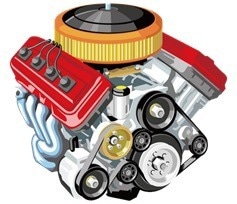While electric vehicles are the future, internal combustion engines will continue to power the majority of vehicles on the road for at least the next ten years. Their environmental impact will continue to be scrutinized as the impacts of climate change affect lives on a daily basis.

Image Credit: Superior Sensor Technology
Enhancing fuel efficiency will aid in reducing this impact. Furthermore, the rapid increase in gasoline prices further drives the need for improved fuel efficiency.
In an internal combustion engine, getting the fuel mixture right is crucial to enhancing fuel efficiency. This composition, however, will vary based on various fluctuating conditions. These variables include vehicle speed, engine and manifold temperature, altitude, humidity, and overall air quality.
To adjust the ignition timing and fuel mixture, in addition to measuring the air temperature with a temperature sensor, air pressure needs to be measured.
Pressure Sensors Monitor Air Pressure
Absolute pressure sensors measure the pressure in relation to a perfect vacuum and should be employed to evaluate air pressure to assess fuel efficiency. Specifically, they measure the pressure both inside the manifold and the outside air pressure (as local air enters the engine).
This “barometric air pressure” has a considerable impact on the fuel mixture. The engine management system can continuously modify the engine to optimize fuel efficiency by reporting this pressure value. This can happen independently of altitude or other fluctuating driving conditions because absolute pressure is being assessed.
NimbleSense™ Architecture Improves Fuel Efficiency Measurements
Superior Sensors’ innovative NimbleSense™ architecture is the industry’s first System-in-a-Sensor integrated platform. It incorporates a highly differentiated advanced pressure sensing system with the ability to integrate optional building blocks to combine the highest accuracy and reliability with lower overall system cost.
This one-of-a-kind technology offers numerous benefits for barometric sensor applications.
Lowest Noise Floor
The noise produced by both the car and external components, such as the road and wind, is one of the biggest impediments to absolute pressure sensors that are used in automobiles.
Superior’s pressure sensors minimize noise generated by these causes before it reaches the sensor sub-system by incorporating powerful digital filtering technology. As a result, the noise is removed before it becomes an error signal that can lead to incorrect air pressure readings.
Highest Levels of Accuracy
There are usually fluctuations in altitude and speed in a moving automobile, which can influence sensor accuracy. To reduce this potential impact, a barometric pressure sensor with the greatest levels of accuracy is required. Superior’s absolute pressure sensors have an industry-leading accuracy of 0.1% of the pressure range and a total error band (TEB) of 0.15%.
Fastest Response Times
As a complement to accuracy, the amount of time it takes the pressure sensor to update its measurement data is just as crucial to fully enhance fuel efficiency. The faster-updated pressure measurements are received, the better the automobile will be able to manage fuel consumption.
While user-configurable, Superior’s absolute pressure sensors support update rates as fast as 2.25 milliseconds.
Solution: ND015A Absolute Pressure Sensor
The ND015A absolute pressure sensor has a pressure range of 0 to 15 psia. It has a variable bandwidth filter with a frequency range of 1 to 200 Hz and a market-leading precision of 0.1%. Other important features of the ND015A include:
- Silicon gel protection
- Temperature compensated from -20 °C to 85 °C
- Supply voltage compensation
- Fully integrated compensation math
- Standard I2C and SPI interfaces
- Highly integrated sensor with ADC and DSP
- Ultra-low noise 16.5-bit resolution
- Exceptional zero stability
- Integrated 50/60 Hz notch filter
- Optional integrate closed loop control
Availability
The ND015A is in production and users can procure it through Digi-Key and Mouser.

This information has been sourced, reviewed and adapted from materials provided by Superior Sensor Technology.
For more information on this source, please visit Superior Sensor Technology.